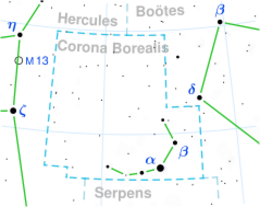Astronomy:Zeta Coronae Borealis
| Observation data {{#ifeq:J2000.0|J2000.0 (ICRS)|Epoch J2000.0 Equinox J2000.0 (ICRS)| [[History:Epoch|Epoch J2000.0]] [[Astronomy:Equinox (celestial coordinates)|Equinox J2000.0}} | |
|---|---|
| Constellation | Corona Borealis |
| ζ1 | |
| Right ascension | 15h 39m 22.247s[1] |
| Declination | +36° 38′ 12.42″[1] |
| Apparent magnitude (V) | 5.95[2] |
| ζ2 | |
| Right ascension | 15h 39m 22.668s[1] |
| Declination | +36° 38′ 08.78″[1] |
| Apparent magnitude (V) | 4.99[2] |
| Characteristics | |
| ζ1 | |
| Evolutionary stage | Main sequence |
| Spectral type | B9 V[2] |
| ζ2 | |
| Evolutionary stage | Main sequence |
| Spectral type | B6 V + B7 V[2] |
| Astrometry | |
| ζ1 | |
| Radial velocity (Rv) | −19.4[3] km/s |
| Proper motion (μ) | RA: −14.199±0.093[4] mas/yr Dec.: −3.871±0.128[4] mas/yr |
| Parallax (π) | 6.2190 ± 0.0685[4] mas |
| Distance | 524 ± 6 ly (161 ± 2 pc) |
| ζ2 | |
| Radial velocity (Rv) | −24.3[3] km/s |
| Proper motion (μ) | RA: −15.624±0.273[5] mas/yr Dec.: −7.310±0.342[5] mas/yr |
| Parallax (π) | 6.6433 ± 0.1841[5] mas |
| Distance | 490 ± 10 ly (151 ± 4 pc) |
| Orbit[6] | |
| Primary | ζ2A |
| Companion | ζ2 B |
| Period (P) | 1.72357 days |
| Eccentricity (e) | 0.013 |
| Inclination (i) | 38° |
| Semi-amplitude (K1) (primary) | 109.6 km/s |
| Semi-amplitude (K2) (secondary) | 121.2 km/s |
| Orbit | |
| Primary | ζ2 AB |
| Companion | ζ2 C |
| Period (P) | 251.5 days |
| Eccentricity (e) | 0.48 |
| Semi-amplitude (K1) (primary) | 28.5 km/s |
| Details | |
| ζ1 A | |
| Mass | 3.19[7] M☉ |
| Rotational velocity (v sin i) | 15[8] km/s |
| ζ2 A | |
| Mass | 4.13[9] M☉ |
| Rotation | 1.7 days[9] |
| Rotational velocity (v sin i) | 46±7[9] km/s |
| ζ2 B | |
| Mass | 3.73[9] M☉ |
| Rotational velocity (v sin i) | 7.5±2[9] km/s |
| ζ2 C | |
| Mass | 3.78[9] M☉ |
| Other designations | |
| ζ1: HR 5833, HD 139891 | |
| ζ2: HR 5834, HD 139892 | |
| Database references | |
| SIMBAD | ζ |
| ζ1 | |
| ζ2 | |
ζ Coronae Borealis, Latinised as Zeta Coronae Borealis, is the Bayer designation of a double star in the constellation Corona Borealis. The two components are separated by six arc-seconds and share the same Hipparcos catalogue number and Flamsteed designation. Each of the two is also a spectroscopic multiple system, with a total of five stars in the group.
Nomenclature
ζ Coronae Borealis has the Flamsteed designation 7 Coronae Borealis and the Hipparcos catalogue number HIP 76669. As a double star, the brighter component is designated A (e.g. WDS J15394+3638 A) while the fainter of the two is designated B. The brighter star is also known as ζ2 Coronae Borealis and the fainter as ζ1 Coronae Borealis.
Each of the pair has its own Bright Star Catalogue and Henry Draper Catalogue numbers: HR 5833 and 5834, and HD 139891 and 139892 for ζ1 and ζ2 respectively.
System
ζ1 Coronae Borealis is a single-lined spectroscopic binary, with an orbital period of about 9.5 days. The nature of the companion is unknown.[7]
The brighter star, ζ2 Coronae Borealis, is a spectroscopic triple system, consisting of three massive stars. The inner pair orbit in 1.7 days, while the outer pair orbit in 251 days.[7]
References
- ↑ 1.0 1.1 1.2 1.3 Cutri, Roc M.; Skrutskie, Michael F.; Van Dyk, Schuyler D.; Beichman, Charles A.; Carpenter, John M.; Chester, Thomas; Cambresy, Laurent; Evans, Tracey E. et al. (2003). "VizieR Online Data Catalog: 2MASS All-Sky Catalog of Point Sources (Cutri+ 2003)". CDS/ADC Collection of Electronic Catalogues 2246: II/246. Bibcode: 2003yCat.2246....0C. http://vizier.u-strasbg.fr/viz-bin/VizieR?-source=II/246.
- ↑ 2.0 2.1 2.2 2.3 Eggleton, P. P.; Tokovinin, A. A. (2008). "A catalogue of multiplicity among bright stellar systems". Monthly Notices of the Royal Astronomical Society 389 (2): 869. doi:10.1111/j.1365-2966.2008.13596.x. Bibcode: 2008MNRAS.389..869E.
- ↑ 3.0 3.1 Wilson, Ralph Elmer (1953). "General catalogue of stellar radial velocities". Washington: 0. Bibcode: 1953GCRV..C......0W.
- ↑ 4.0 4.1 4.2 Brown, A. G. A. (August 2018). "Gaia Data Release 2: Summary of the contents and survey properties". Astronomy & Astrophysics 616: A1. doi:10.1051/0004-6361/201833051. Bibcode: 2018A&A...616A...1G. Gaia DR2 record for this source at VizieR.
- ↑ 5.0 5.1 5.2 Brown, A. G. A. (August 2018). "Gaia Data Release 2: Summary of the contents and survey properties". Astronomy & Astrophysics 616: A1. doi:10.1051/0004-6361/201833051. Bibcode: 2018A&A...616A...1G. Gaia DR2 record for this source at VizieR.
- ↑ Gordon, K. D.; Mulliss, C. L. (1997). "Zeta$^2$ Coronae Borealis, A Spectroscopic Triple System Including an Asynchronous Close Binary". Publications of the Astronomical Society of the Pacific 109: 221. doi:10.1086/133877. Bibcode: 1997PASP..109..221G.
- ↑ 7.0 7.1 7.2 "Multiple Star Catalogue". http://www.ctio.noao.edu/~atokovin/stars/stars.php?cat=HR&number=5833.
- ↑ Abt, Helmut A.; Levato, Hugo; Grosso, Monica (2002). "Rotational Velocities of B Stars". The Astrophysical Journal 573 (1): 359. doi:10.1086/340590. Bibcode: 2002ApJ...573..359A.
- ↑ 9.0 9.1 9.2 9.3 9.4 9.5 Tokovinin, A. (2008). "Comparative statistics and origin of triple and quadruple stars". Monthly Notices of the Royal Astronomical Society 389 (2): 925–938. doi:10.1111/j.1365-2966.2008.13613.x. Bibcode: 2008MNRAS.389..925T.
 |


